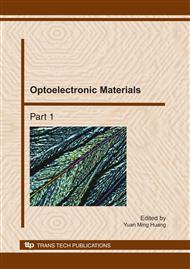p.934
p.939
p.943
p.947
p.952
p.956
p.961
p.965
p.969
Synthesis of Ethyl Cellulose-Based Thermal- and Photodual- Responsive Copolymer via ATRP and their Aggregates in Aqueous Solution
Abstract:
Ethyl cellulose-graft-poly(N-isopropylacrylamide-co-6-[4-(4-ethoxyphenylazo)phenoxy] hexyl methacrylate) (EC-g-P(NIPAM-co-MAZO)) were synthesized through atom transfer radical polymerization (ATRP). Ethyl cellulose-based macroinitiator was prepared by direct acrylation of ethyl cellulose with excess 2-bromoisobutyryl bromide at room temperature, the bromo-ester groups of which were known to be efficient initiator for ATRP. Statistical copolymerization of N-isopropylacrylamide (NIPAM) and 6-[4-(4-ethoxyphenylazo)phenoxy] hexyl methacrylate (MAZO) onto ethyl cellulose (EC) was achieved using CuCl/Me6TREN as the catalyst system and N,N-dimethylformamide/water mixture (DMF/H2O, v/v = 4:1) as solvent. Appropriate solvent concentration and polymerization temperature can minimize the intermolecular coupling and render the polymerization controllable. The aggregates formed by EC-g-P (NIPAM-co-MAZO) copolymer in aqueous solution were investigated by varying temperature and irradiation under UV/visible light. The results indicated that the copolymer had thermal- and photo- dual-responsive properties. The copolymer formed a comparatively stable suspension in water at room temperature and underwent a hydrophilic-hydrophobic transition when the temperature raised. Furthermore, their aggregates in water were influenced by isomerization of azobenzene groups under UV/visible light irradiation.
Info:
Periodical:
Pages:
952-955
Citation:
Online since:
November 2010
Authors:
Price:
Сopyright:
© 2011 Trans Tech Publications Ltd. All Rights Reserved
Share:
Citation:


